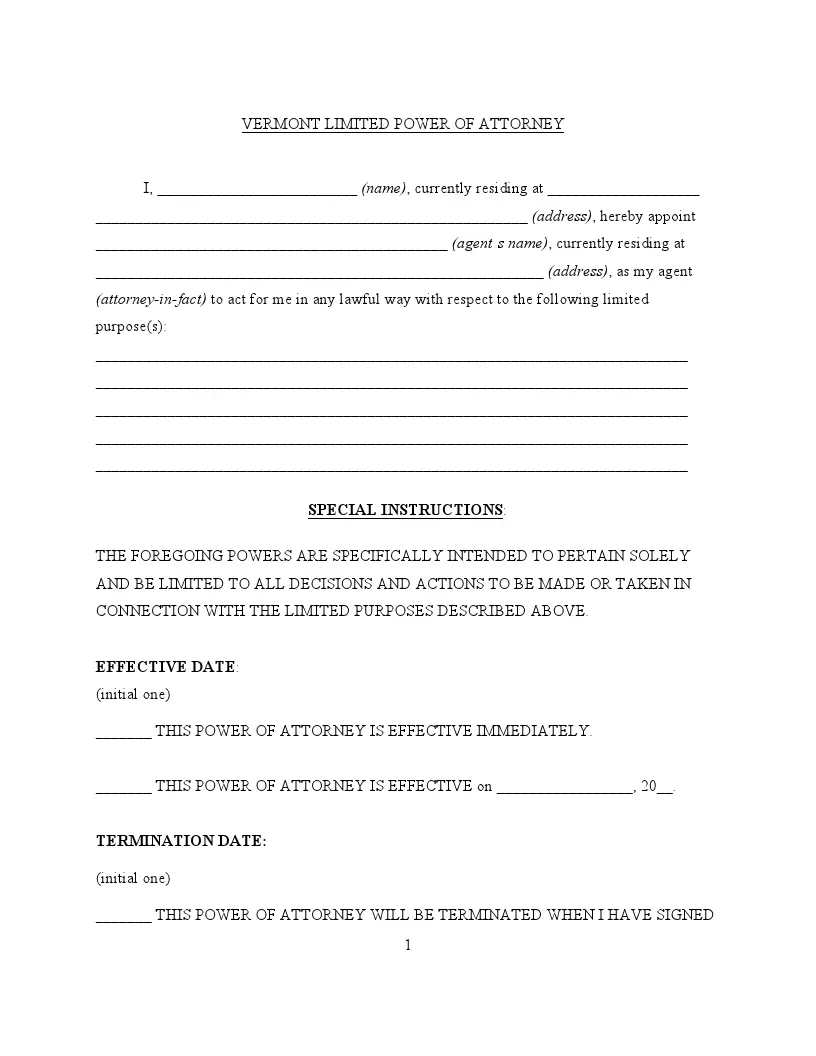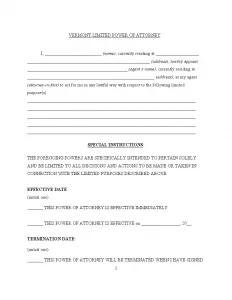Vermont Limited Power of Attorney Form
The Vermont limited power of attorney is a legal document that allows an individual, known as the principal, to designate another person, referred to as the agent, to perform specific actions on their behalf. This arrangement is often used for a particular transaction or a set period. The scope of authority could include handling financial transactions, selling property, or managing other designated affairs.
The principal must ensure the document clearly states the scope of powers. To be legally binding in Vermont, it should be signed in the presence of a notary. This specificity helps protect the principal’s interests while effectively managing specified matters.
FormsPal offers Vermont power of attorney forms to help you manage your legal authorizations efficiently.

Build Your Document
Answer a few simple questions to make your document in minutes
Save and Print
Save progress and finish on any device, download and print anytime
Sign and Use
Your valid, lawyer-approved document is ready
The Vermont Statutes Annotated (14 V.S.A. § 4001 – 14 V.S.A. § 4063) provide the legal framework for executing a limited power of attorney. For legal validity, this document requires:
- The principal’s signature, which may be executed by another person (if done under the express direction and in the presence of the principal).
- Official signature acknowledgment is required before a notary public or another official is authorized to take acknowledgments.
Under 14 V.S.A. § 4005, the presence of a notary public or an equivalent official is essential to verify the authenticity of the principal’s signature. It helps to confirm the principal’s identity and their voluntary decision to grant authority to the agent.
Vermont Limited Power of Attorney Form Details
| Document Name | Vermont Limited Power of Attorney Form |
| Other Name | Vermont Special Power of Attorney |
| Relevant Laws | Vermont Statutes Annotated, Title 14, Chapter 127 |
| Avg. Time to Fill Out | 8 minutes |
| # of Fillable Fields | 32 |
| Available Formats | Adobe PDF |
Filling Out Vermont Limited POA
A limited power of attorney in Vermont allows you to grant specific powers to another person, enabling them to act on your behalf under precise circumstances. Completing this form correctly ensures that all actions taken by your agent are valid and recognized under Vermont law.
1. Fill Out the Principal Information
Begin by writing your full name and residential address in the designated spaces at the beginning of the form. This will identify you as the principal who is granting the power.
2. Appoint Your Agent
In the next section, specify the name and address of the person you wish to appoint as your agent (also known as the attorney-in-fact). This person will be authorized to act on your behalf according to the powers you grant in this document.
3. Define the Scope of Powers
Clearly describe the specific powers you are delegating to your agent. Be as precise as possible to avoid ambiguity about what your agent is authorized to do.
4. Set the Effective and Termination Dates
Choose whether the form will take effect immediately or start on a specific future date. Then, decide how the limited power of attorney will end — whether after a certain event, on a specific date, or when you revoke it.
5. Designate a Successor Agent
If you wish, appoint a successor agent who will take over if your primary agent cannot fulfill their role. Include the successor’s name and address.
6. Sign and Date the Form
Sign and date the form in the presence of a notary public. This step legally executes the document and confirms your intent to grant power to your agent.
7. Notarization
The final step is the notarization of the form. The notary public will verify your identity and witness your signature, then seal the document, making it legally effective.
